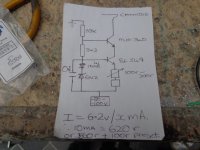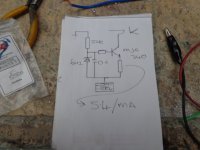I've used these two CCS's loads of times with good results, easy to find parts and rock solid, the first has higher Z, but the second works absolutely fine too for LTP's, cathode followers etc. I make the emitter resistor adjustable with a little preset, allows you to adjust to get Vk bang on or experiment with different current. You can just use a fixed R though.
You can use a BD139 instead of the MJE340 if your negative rail is within Vce of the 139, the MJ340 is better though. On the first version any NPN small signal Q with a highish gain will do. I bolt my MJE340 to the chassis of the amp mounted right near the cathode, with a sil pad of coarse, saves a heatsink.
The resistor on the base of the MJE340 in version two is 100r, not strictly needed but helps with stability. As for caps across the zeners any cap will do to a point, what ever you have to hand.
For a negative supply a bridge rectifier, and two or three 470u caps with something like 150r to 680r resistors to form to RC filters is all that's needed
Andy.
You can use a BD139 instead of the MJE340 if your negative rail is within Vce of the 139, the MJ340 is better though. On the first version any NPN small signal Q with a highish gain will do. I bolt my MJE340 to the chassis of the amp mounted right near the cathode, with a sil pad of coarse, saves a heatsink.
The resistor on the base of the MJE340 in version two is 100r, not strictly needed but helps with stability. As for caps across the zeners any cap will do to a point, what ever you have to hand.
For a negative supply a bridge rectifier, and two or three 470u caps with something like 150r to 680r resistors to form to RC filters is all that's needed
Andy.
Attachments
Last edited:
There's a minor typo in the first image of post #21. It should say
R = 6.2V / (x mA)
because this is just Ohm's Law (Voltage = Current * Resistance), rearranged to the form (Resistance = Voltage / Current)
R = 6.2V / (x mA)
because this is just Ohm's Law (Voltage = Current * Resistance), rearranged to the form (Resistance = Voltage / Current)

